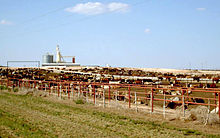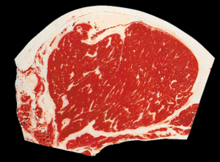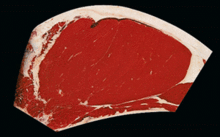Lentis/Corn, Beef and Feedlots


Corn Fed vs. Grass Fed Beef
[edit | edit source]Advancing technology in agriculture has changed cattle feeding practices and farming terminology within the commercial meat industry. While cattle traditionally grazed grass fields for nourishment, farmers have shifted cattle to grain (corn) silage in feedlots. Grass-fed beef are cattle that feed only on natural grass throughout their lives before being slaughtered. Similarly, cattle that eat a corn-supplemented diet are labeled corn-fed beef. However, producers coined the term 'finished' to identify the period of time cattle are normally fattened over the last 90 to 160 days before being slaughtered. This differentiation allows producers to brand their beef as grass-fed, although it is grain-finished, to appeal to health-conscious consumers.
Is the difference in taste worth the difference in market price and potential health problems?
[edit | edit source]The debate between corn-fed and grass-fed beef poses nutritional, financial, and taste consequences for consumers. While choosing corn-fed beef or grass-fed beef is a personal preference, grass fed beef is more likely to appeal to those who favor Rib-eye cuts or New York Strip steaks because they are leaner than fillet cuts, which are predominantly grain-fed beef.
Why has the meat industry made this switch
[edit | edit source]Most modern farming techniques use commercial corn feedlots to raise cattle. The switch from grass grazing to corn feeding has been profitable for US meat industry by reducing a calf's time to slaughter. Since the mid-1990s, corn has been an "icon of unsustainable agriculture" because it receives more government subsidies than any other product [1].
Corn Subsidies
[edit | edit source]While cattle prices continue to rise dramatically, the cost of corn has increased at a lesser rate. With heavy federal subsidies, the surplus of corn makes an easy, low cost solution to fattening cattle quickly, which makes it the most widespread and cheapest available type of beef for supermarket and restaurant buyers. From 1995 to 2009, corn subsidies accounted for over $75 billion dollars [2]. These agricultural subsidies are direct monetary supplements paid by the government to farmers, which help supplement their income. Michael Pollan, an opponent of corn-fed beef, calculated that the $2.75 cost to grow a bushel of corn is actually $0.50 higher than $2.25 sale price per bushel [3]. The difference is paid out to farmers as a government subsidy, which is ultimately funded by taxpayers.


United States Department of Agriculture (USDA) Grading System
[edit | edit source]The ubiquity of corn-fed beef within American food has heightened its popularity. American consumers have unknowingly adopted a preferred taste for corn-fed beef. The USDA marbling standards grade corn fed beef highest. People are happily paying less for a more tender, juicier, and sweeter grade of beef over the tougher grass-fed texture. According to social activist John Robbins, "a corn-fed cow does develop well-marbled flesh, but this is simply saturated fat that can’t be trimmed off. Grass-fed meat, on the other hand, is lower both in overall fat and in artery-clogging saturated fat" [4]. The USDA promotes highly marbled cuts as the finest quality of 'prime' meat, while those with less marbleizing falls into lower 'select' grades, shown in the images on the right.
Competition within Meat Industry
[edit | edit source]Government corn subsidies slightly skew competition for beef producers by intervening in the open market. Small farms are constantly fighting competition from large scale factory farms who employ the most cost-efficient production methods. Since 1921, the Packers & Stockyards Act has failed to address the problem that "large processing companies pay less to smaller farmers than they do to large contract farmers, and they don’t pass the savings along to consumers" [5]. As suitable pastures become more limited and less economical, the expansion of large scale factory farms producing corn-fed beef dominate the meat industry, forcing small U.S family farms to go out of business; thus, lessening the available supply of grass-fed beef.
Relevant Social Groups
[edit | edit source]Farmer's Perspectives
[edit | edit source]Feeding cows fermented corn and grain byproducts is more profitable for the farming industry [6]. Without government subsidies, it would be nearly impossible for farmers to meet rising production costs and earn a sustainable income for their families. Similarly, these subsidies also deflect the increasing prices consumers' pay for ground beef, steaks, and ribs.
To satisfy increased US population and consumer demand, farmers discovered grain-based feed fattens cattle two to three times faster than traditional grass grazing. Grass pastures are not readily available year-round. The combination of inadequate farmlands and seasonality increases the cost associated with purely grass-fed cattle [7]. Farmers fear the risk of consumer substitution if they fail to look for alternatives to reduce cost and lower their market prices for beef. Scott Oswalt, a farmer from Vicksburg, MI, says, "As a feeder, we don't want [the fair price] to get too high, either. Once a steak gets so high people are going to turn to other meats... People are just going to back off" [8].
Feeding cows corn, protein supplements, antibiotics, and growth hormones in feedlots enhance farming productivity by fattening cattle within 14-16 months in the same pastoral space that would have traditionally taken a small herd up to five years of grazing before entering a slaughter house [4]. While farming feedlots inevitably produce larger waste areas than traditional pasture grazing, these feedlots force farmers to be more attentive to waste disposal and more environmentally aware. According to Dr. Jude Capper, an assistant professor at Washington State University, "[Grass-fed cattle] have a far lower efficiency, far lower productivity. The animals take 23 months to grow, while corn-fed cattle need only 15. That's eight extra months of feed, water, land use...and an awful lot of waste. If we have a grass-fed animal, compared to a corn-fed animal, that's like adding almost one car to the road for every single animal. That's a huge increase in carbon footprints" [9].
Family's Income and Health
[edit | edit source]For families there are both pros and cons to consuming corn-fed beef. Corn-fed beef is cheap because corn is highly subsidized and cows reach maturity quicker, but is also less healthy.
In today's economy, many people are limited to fast foods because they cannot afford to buy healthy foods. With less than one percent of federal subsidies going towards fruits and vegetables, families are forced to balance between what is convenient and what they can afford. Sadly, some families can only afford fast food, and find other ways to meet their nutritional needs [10].
Food Industry
[edit | edit source]Fast food is most relevant concerning cheap foods for the family because one third of children eat fast food on any given day [11]. In the United States, there are over 50,000 locations of the top ten fast food chains, which produce over $100 billion of food each year. In fast food restaurants, the majority of products sold contain a corn byproduct. Examples include hamburgers made of corn-fed beef, soda containing corn sweetener, buns containing high fructose syrup, and even french fries cooked in corn oil. Since cost is the primary concern of the major fast food chains, corn-fed beef help restaurants maintain a low competitive price for its cheap food, such as $1 hamburgers.
Fine restaurants have seen a decrease in premium beef sales because the recession has caused consumers to spend less on luxury items. Oswalt commented, "when the high-end restaurants are slower from the economy, those higher cuts of meat don't sell. [But] we need those to sell. There's more profit in those than in the burger" [8]. Also, restaurants shy away from offering grass-fed steaks to avoid customer complaints that its meat is tough and not flavorful without marbling.
Nutritional Concerns
[edit | edit source]Though corn fed beef is cheap, it has nutritional consequences. The biggest issue with corn-fed beef for the families is obesity. Fifteen percent of children and thirty three percent of adults are now obese [11]. Obesity leads to major health issues like diabetes, high blood pressure, heart attacks, etc. Because of this growing issue of obesity, this is the first time ever that the lifetime expectancy of the next generation is less than their parents.
Grass-fed beef is healthier than corn-fed beef. It is typically leaner, less caloric, and lowers cholesterol. Grass-fed beef contains two to six times more omega-3 fatty acids than corn-fed beef. These fatty acids help lower blood pressure and help irregular heartbeats. They've also been proven to help with psychological issues, like depression and schizophrenia. Beef raised on grass contains about five times more conjugated linoleic acid (CLA)than corn-fed beef which reduces the risk of cancer. Vitamin E is an antioxidant that also helps lower the risk of cancer and heart disease, and is four times greater in grass-fed beef than in corn-fed beef [12].
The Cow's Standard of Living
[edit | edit source]Increasing feedlot size has brought related health issues to light. To combat feedlot related health issues, livestock owners now give antibiotics to all of their livestock, not just the sick ones. The Union of Concerned Scientists states that livestock use 70% (24.6 million pounds) of the antibiotics in the United States, and this estimate can be up to 84% for all agricultural uses combined [13].
Sanitation
[edit | edit source]A feedlot has cattle concentrations up to 360 cows/acre [14]. Such tight proximity causes problems with waste removal. Calf scours are a major problem caused by the high levels of harmful bacteria that build up in waste concentrates. A herd of 2,500 cattle produce as much waste as a city of 411,000 people, which is the size of Miami, FL[15]. While some of this waste can be spread on fields and used as fertilizer, the remainder is disposed of in large outdoor pits called manure lagoons [16]. These lagoons emit gasses and nitric oxides – main contributors to acid rain. Leaks in the manure lagoons can pollute the public water supply and infect humans. Storage of manure in pits has also lead to the death of over thirty workers between 1992 and 1997, who either drowned or choked to death on manure gasses [17]. To combat waste pollution, a 2002 law instated a waste disposal permit for feedlots, to ensure safe treatment of waste [18].
Acidosis
[edit | edit source]Acidosis is a condition when the pH of the rumen, the cows largest stomach, drops from 7.0 to below 5.5 [19]. When the cow eats too much high energy food, such as corn, bacteria in the rumen to overact and produce an excess of acid, which, in severe cases is absorbed into the bloodstream and causes the cow to go into shock and die.
Cattle Feed Ingredients
[edit | edit source]In 1997 the FDA banned feeding cattle back to cattle after it was proven that mad-cow disease spreads by feeding infected carcasses to healthy cattle. These regulations prohibited feeding cattle "any protein derived from mammalian animals" with several exceptions [20]. Pigs, horses, poultry, fish, milk products, euthanized cats and dogs, waste manure from any animals, and cattle blood and gelatin can all legally still be put in cattle feed [20][21]. This current law allows poultry and swine that have been fed cattle parts to be fed back to cattle, which could possibly allow mad-cow disease to travel through these animals and back to the cattle [21].
References
[edit | edit source]- ↑ Keim, Brandon, 2008. "Fast Food: Just another name for Corn". http://www.wired.com/wiredscience/2008/11/fast-food-anoth/
- ↑ "Farm Subsidy Database" http://farm.ewg.org/progdetail.php?fips=00000&progcode=corn
- ↑ "Power Steer". New York Times, 2002. http://www.nytimes.com/2002/03/31/magazine/power-steer.html?pagewanted=10
- ↑ a b John Robbins, 2010. "What about Grass-fed Beef?". http://www.johnrobbins.info/blog/grass-fed-beef/
- ↑ Bindell, Rich. "Choice Cuts of Meat—But is the Choice Ours or Theirs?". Food and Water Watch. August 2010. http://www.foodandwaterwatch.org/2010/08/choice-cuts-of-meat%E2%80%94but-is-the-choice-ours-or-theirs/
- ↑ WSJ.com Digital Network. "The Cost of Corn-Fed Cattle". Wall Street Journal Online, 2008. http://www.youtube.com/watch?v=p_pLy7Gjlww
- ↑ "American Meat Institute Fact Sheet: Corn-Fed vs Grass-Fed". March 2010. http://www.meatami.com/ht/a/GetDocumentAction/i/58166
- ↑ a b The Associated Press, 2010. "Falling cattle prices, rising corn prices put the squeeze on Michigan's beef farmers". http://www.mlive.com/business/west-michigan/index.ssf/2010/11/falling_cattle_prices_rising_c.html
- ↑ "Grass-Fed Cattle Bad for the Environment". http://www.newsmax.com/Stossel/cattle-grass-fed/2010/11/17/id/377301
- ↑ "Farm subsidies not in sync with food pyramid". http://www.msnbc.msn.com/id/8904252/ns/health-fitness/
- ↑ a b "Fast food linked to childhood obesity". http://www.cbsnews.com/stories/2004/01/05/health/main591325.shtml
- ↑ "The Health Benefits of Grass Farming" http://www.americangrassfedbeef.com/grass-fed-natural-beef.asp
- ↑ "Hogging It!: Estimates of Antimicrobial Abuse in Livestock (2001) http://www.ucsusa.org/food_and_agriculture/science_and_impacts/impacts_industrial_agriculture/hogging-it-estimates-of.html
- ↑ "Managing Odor Nuisance and Dust from Cattle Feedlots" http://www.ag.ndsu.edu/pubs/h2oqual/watnut/nm1391.html
- ↑ "Risk Assessment Evaluation for Concentrated Animal Feedlot Operations" http://www.epa.gov/nrmrl/pubs/600r04042/600r04042.pdf
- ↑ "Sustainable Table" http://www.sustainabletable.org/issues/waste/#fn1
- ↑ "National Institute for Occupational Safety and Health" http://www.cdc.gov/niosh/docs/nioshrecsdolhaz/pdfs/dol-recomm.pdf
- ↑ US EPA: "Animal Feeding Operations Fact Sheets and Outreach Materials" http://cfpub.epa.gov/npdes/docs.cfm?document_type_id=3&view=Fact%20Sheets%20and%20Outreach%20Materials&program_id=7&sort=name
- ↑ "How a Cow Chows" http://findarticles.com/p/articles/mi_m1590/is_8_58/ai_82554154/
- ↑ a b Food and Drug Administration "BSE/Ruminant Feed Ban Inspections" http://www.fda.gov/downloads/AnimalVeterinary/GuidanceComplianceEnforcement/ComplianceEnforcement/UCM113437.pdf
- ↑ a b "They Eat What? The Reality of Feed at Animal Factories" http://www.ucsusa.org/food_and_agriculture/science_and_impacts/impacts_industrial_agriculture/they-eat-what-the-reality-of.html#Same_Species_Meat_Diseased_Animals_and_F